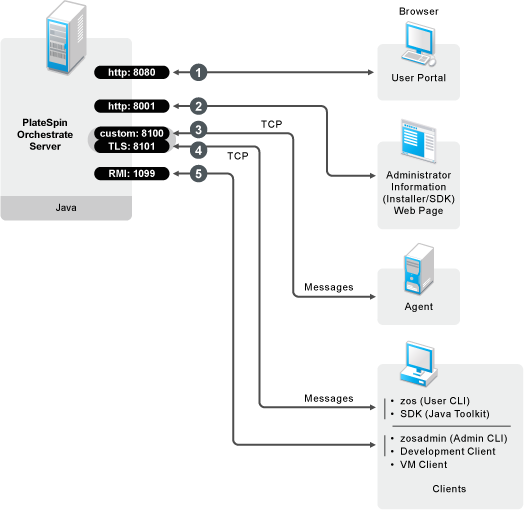2.4 How PlateSpin Orchestrate Components Communicate
The following diagram illustrates how the various components of PlateSpin Orchestrate communicate with the Orchestrate Server. An explanation for each communication link follows the diagram.
Figure 2-2 Communication Ports Used By the Orchestrate Server

-
To open the Server Portal for managing jobs in a Web browser, enter the URL of the Orchestrate Server followed by the port designated for the Server Portal during installation. In a basic installation of PlateSpin Orchestrate, this is port 8080. The URL would therefore be entered as follows:
http://DNS_Name_or_IP_Address:8080
-
Administrators who want more information about PlateSpin Orchestrate and a method to access or install additional clients or agents can access the Administrator Information page. To do so, open a Web browser and enter the URL to the Orchestrate Server, followed by the port designated for the Web Info page during installation. In a basic installation of PlateSpin Orchestrate, the default is port 8001. The URL would therefore be entered as follows:
http://DNS_Name_or_IP_Address:8001
-
The Orchestrate Server establishes and maintains contact with an installed Orchestrate Agent on a computing resource through port 8100, using a custom protocol.
-
When a user invokes the zos command line interface (available after PlateSpin Orchestrate clients are installed on a machine), or when using the Java toolkit SDK, those client tools communicate with the Orchestrate Server over ports 8100 and 8101.
-
When the administrator invokes the zosadmin command line interface (available after PlateSpin Orchestrate clients — including the Orchestrate Development Client — are installed on a machine), or when using the PlateSpin Orchestrate Development Client, those client tools communicate with the Orchestrate Server over port 1099, which uses a Java RMI (Remote Method Invocation) protocol.